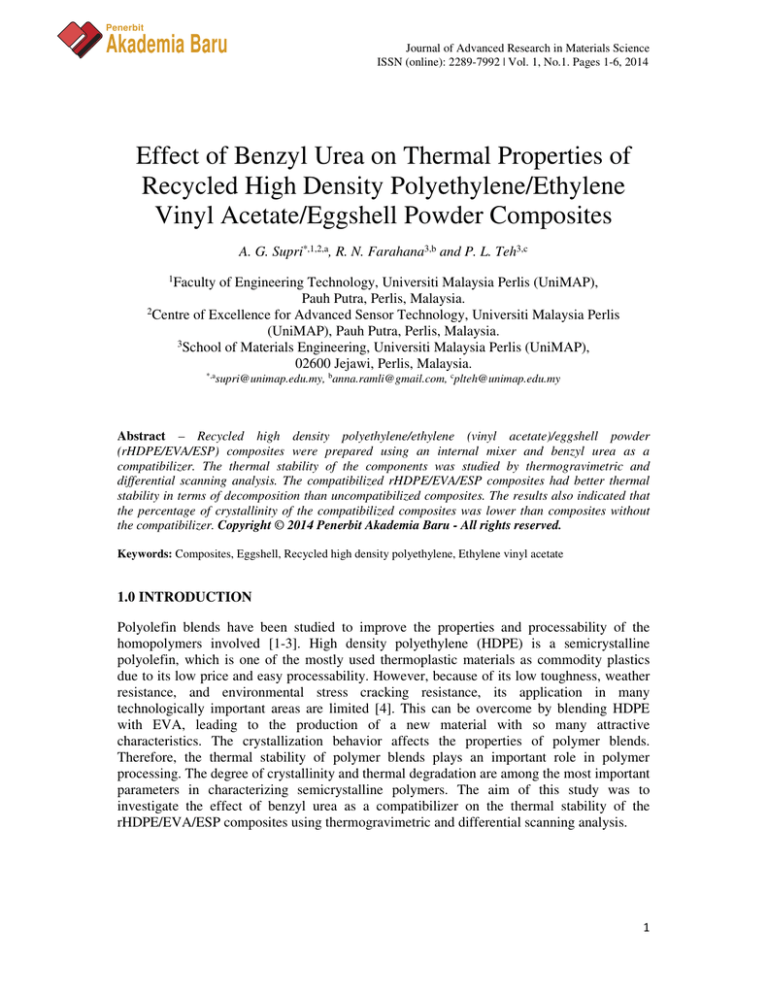
Penerbit
Akademia Baru
Journal of Advanced Research in Materials Science
ISSN (online): 2289-7992 | Vol. 1, No.1. Pages 1-6, 2014
Effect of Benzyl Urea on Thermal Properties of
Recycled High Density Polyethylene/Ethylene
Vinyl Acetate/Eggshell Powder Composites
A. G. Supri*,1,2,a, R. N. Farahana3,b and P. L. Teh3,c
1Faculty
of Engineering Technology, Universiti Malaysia Perlis (UniMAP),
Pauh Putra, Perlis, Malaysia.
2Centre of Excellence for Advanced Sensor Technology, Universiti Malaysia Perlis
(UniMAP), Pauh Putra, Perlis, Malaysia.
3School of Materials Engineering, Universiti Malaysia Perlis (UniMAP),
02600 Jejawi, Perlis, Malaysia.
*,a
supri@unimap.edu.my, banna.ramli@gmail.com, cplteh@unimap.edu.my
Abstract – Recycled high density polyethylene/ethylene (vinyl acetate)/eggshell powder
(rHDPE/EVA/ESP) composites were prepared using an internal mixer and benzyl urea as a
compatibilizer. The thermal stability of the components was studied by thermogravimetric and
differential scanning analysis. The compatibilized rHDPE/EVA/ESP composites had better thermal
stability in terms of decomposition than uncompatibilized composites. The results also indicated that
the percentage of crystallinity of the compatibilized composites was lower than composites without
the compatibilizer. Copyright © 2014 Penerbit Akademia Baru - All rights reserved.
Keywords: Composites, Eggshell, Recycled high density polyethylene, Ethylene vinyl acetate
1.0 INTRODUCTION
Polyolefin blends have been studied to improve the properties and processability of the
homopolymers involved [1-3]. High density polyethylene (HDPE) is a semicrystalline
polyolefin, which is one of the mostly used thermoplastic materials as commodity plastics
due to its low price and easy processability. However, because of its low toughness, weather
resistance, and environmental stress cracking resistance, its application in many
technologically important areas are limited [4]. This can be overcome by blending HDPE
with EVA, leading to the production of a new material with so many attractive
characteristics. The crystallization behavior affects the properties of polymer blends.
Therefore, the thermal stability of polymer blends plays an important role in polymer
processing. The degree of crystallinity and thermal degradation are among the most important
parameters in characterizing semicrystalline polymers. The aim of this study was to
investigate the effect of benzyl urea as a compatibilizer on the thermal stability of the
rHDPE/EVA/ESP composites using thermogravimetric and differential scanning analysis.
1
Penerbit
Akademia Baru
Journal of Advanced Research in Materials Science
ISSN (online): 2289-7992 | Vol. 1, No.1. Pages 1-6, 2014
2.0 METHODOLOGY
2.1 Materials
rHDPE with a melt flow index of 0.7 g/10 min (190°C) and a density of 939.9 kg/m3 was
used. EVA contains 6.5 wt% VA, with melt index of 2.5 g/10 min (80 °C; 2.16 kg) and a
density of 0.93 g/cm3 was supplied from A.R. Alatan Sdn. Bhd., Kedah Darul Aman,
Malaysia. The eggshell was obtained from a local poultry industry in Negeri Sembilan,
Malaysia.
2.2 Sample preparation
For the ESP preparation, the eggshell was washed, dried, and ground to powder using kitchen
blender. ESP with average filler sizes of 63 ૄm was dried in a vacuum oven at 80 °C until the
constant weight was obtained as reported by Suhadah et al [5]. For composites preparation,
the compounding of the blends was carried out by melt blending in Brabender internal mixer.
The rHDPE was first mixed in the internal mixer at 190 °C and 50 rpm for 4 min, and then
the pre-weighed amount of EVA, BU, DCP, and ESP were added to the mixer for the next 6
min. Each of the molten samples was compressed and molded into sheets of 2 mm thickness
using a hydraulic press at 190 °C for 2 min and cooled under pressure for 4 min. Table 1
shows the formulation used in this study.
Table 1: Formulations of rHDPE/EVA/ESP and rHDPE/EVA/ESPBU composites
Composite code
rHDPE[phr]
EVA[phr]
ESP[phr]
BU[phr]
DCP[phr]
rHDPE/EVA
50
50
-
-
-
rHDPE/EVA/ESP5
50
50
5
-
-
rHDPE/EVA/ESP10
50
50
10
-
-
rHDPE/EVA/ESP15
50
50
15
-
-
rHDPE/EVA/ESP20
50
50
20
-
-
rHDPE/EVA/ESP25
50
50
25
-
-
rHDPE/EVA/ESP5-BU
50
50
5
6
1
rHDPE/EVA/ESP10-BU
50
50
10
6
1
rHDPE/EVA/ESP15-BU
50
50
15
6
1
rHDPE/EVA/ESP20-BU
50
50
20
6
1
rHDPE/EVA/ESP25-BU
50
50
25
6
1
2
Penerbit
Akademia Baru
Journal of Advanced Research in Materials Science
ISSN (online): 2289-7992 | Vol. 1, No.1. Pages 1-6, 2014
2.3 Characterization and measurements
Thermal stability of the composites was investigated by thermogravimetric analysis (TGA)
by using a Perkin Elmer TGA instrument [Model: Pyris Diamond TG/DTA] from ambient
temperature to 700°C at a programmed heating rate of 10 °C/min in nitrogen. A sample
weight of approximately 10 mg was taken for all the measurements. The weight loss against
temperature was recorded. The melting and crystallization behavior of rHDPE/EVA/ESP
composites were evaluated using Perkin Elmer DSC thermal system USA. Samples were
scanned at a heating and cooling rate of 10 °C/min in nitrogen atmosphere. Samples weighing
about 5 mg were used for the DSC. The percentage crystallinity (XC) of the rHDPE phase has
been determined by Eq. 1, where ∆Hm is the heat of melting of the semi-crystalline rHDPE
composites, and ∆Hm0 is the heat of melting for 100 % crystalline rHDPE, which is 293 J/g
[6].
Xc =
∆H m
× 100%
∆H mo
(1)
3.0 RESULTS AND DISCUSSION
3.1 Thermogravimetric Analysis
Figures 1(a) and 1(b) demonstrate the thermogravimetric curves of rHDPE/EVA/ESP and
rHDPE/EVA/ESPBU composites at different filler loading. As shown in Figure 1, all samples
display a two-step thermal degradation process. The first stage occurring between 250 and
300 °C is related to the deacylation of the EVA phase through radical and ionic β-elimination
mechanisms [7]. In addition, the second step (400-450 °C) involves the degradation of the
HDPE phase accompanied with the decomposition of the polyacetylene-ethylene chains
formed in the first stage [7].
(a)
(b)
Figure 1: TGA curves of (a) rHDPE/EVA/ESP and (b) rHDPE/EVA/ESP-BU composites
with different filler loading.
Table 2 shows the temperature of 50 % weight loss (T-50%wt), final decomposition
temperature, and residual mass for both series of the composites. Table 2 shows that the
temperature at 50% weight loss, the final decomposition temperature, and the residual mass
3
Penerbit
Akademia Baru
Journal of Advanced Research in Materials Science
ISSN (online): 2289-7992 | Vol. 1, No.1. Pages 1-6, 2014
of the rHDPE/EVA/ESP and rHDPE/EVA/ESP-BU composites increased with an increase in
the filler loading. These results show that higher filler loading gives the rHDPE/EVA/ESP
composites more thermal stability than the lower filler loading. Meanwhile, the temperature
of 50% weight loss and final decomposition temperature for rHDPE/EVA/ESPBU are higher
than rHDPE/EVA/ESP composites. This indicates that the present of BU increased the
thermal stability of the composites due to better interfacial adhesion between ESP and
rHDPE/EVA matrix.
3.2 Differential Scanning Calorimetry
DSC thermograms of rHDPE/EVA/ESP composites and rHDPE/EVA/ESPBU composites are
shown in Figure 2. The values of melting temperature (Tm) and % crystallinity for
rHDPE/EVA/ESP and rHDPE/EVA/ESPBU composites are summarized in Table 2. The DSC
curves in Figure 2 show endothermic melting peaks around 126-127 °C. Although there was
very little change in the melting peak temperatures of the composites, it be seen that the
melting endothermic temperature seem to decrease with the increase of filler content for both
sets of the composites.
Table 2: Data for T-50 wt.%, final decomposition temperature, and residual mass of
rHDPE/EVA/ESP and rHDPE/EVA/ ESPBU composites at different ESP loading.
T-50 wt.% (°C)
Final decomposition
temperature (°C)
Residual mass (%)
rHDPE/EVA
425.82
531.33
0.002
rHDPE/EVA/ESP-5
426.66
693.05
1.628
rHDPE/EVA/ESP-15
460.56
693.28
3.800
rHDPE/EVA/ESP-25
470.76
694.28
4.645
rHDPE/EVA/ESP-5BU
436.92
700.00
6.238
rHDPE/EVA/ESP-15BU
462.28
700.00
15.460
rHDPE/EVA/ESP-25BU
472.31
700.00
23.820
Blend composition
The increasing amount of filler in the composites decreased the melting enthalpies. This
expected, since the melting enthalpies are related to the amount of polymer in the sample,
hence the melting peak sizes and related enthalpies should decrease correspondingly [8].
However, the presence of the filler may influence the crystallization behaviour of the
composites. The results show that the percentage of crystallinity for both composites
decreased as the filler loading increased.
This may be due to the immobilized rHDPE/EVA matrix by the addition of ESP, which
results in a reduced crystallization of the composites [9]. On the other hand,
rHDPE/EVA/ESPBU composites displayed slightly higher melting temperatures but lower
crystallinity than rHDPE/EVA/ESP composites at the same filler loading. Li et al. [10]
reported that the compatibilizer improved wood flour/polypropylene interactions, which
restricted the mobility of PP chains and hindered the crystallization process.
4
Penerbit
Akademia Baru
Journal of Advanced Research in Materials Science
ISSN (online): 2289-7992 | Vol. 1, No.1. Pages 1-6, 2014
(a)
(b)
Figure 2: DSC curves of (a) rHDPE/EVA/ESP and (b) rHDPE/EVA/ESPBU composites with
different filler loading.
Table 3: Thermal DSC parameters for rHDPE/EVA/ESP and rHDPE/EVA/ESPBU
composites at different ESP loading.
Blend composition
Tm (°C)
Percentage of crystallinity (%)
rHDPE/EVA
126.91
40.85
rHDPE/EVA/ESP-5
127.14
35.25
rHDPE/EVA/ESP-15
126.66
32.28
rHDPE/EVA/ESP-25
127.22
31.28
rHDPE/EVA/ESP-5BU
128.02
35.24
rHDPE/EVA/ESP-15BU
127.64
32.23
rHDPE/EVA/ESP-25BU
127.28
27.11
4.0 CONCLUSION
The addition of BU as a compatibilizer in the rHDPE/EVA/ESP composites was evaluated.
The thermal degradation of the composites increased the addition of filler. The compatibilizer
BU enhanced the thermal stability of the composites due to better interfacial adhesion
between the components of the composites. Meanwhile, the presence of the filler reduced the
crystallization of the composites due to immobilized rHDPE/EVA matrix by filler. On the
other hand, the BU compatibilizer improved the interactions of the component, and therefore
the percentage of crystallization of compatibilized composites lower than the composites
without the BU compatibilizer.
5
Penerbit
Akademia Baru
Journal of Advanced Research in Materials Science
ISSN (online): 2289-7992 | Vol. 1, No.1. Pages 1-6, 2014
REFERENCES
[1]
D. Imren, A. Boztug, E. Yılmaz, H.B. Zengin, Viscometric investigation of
compatibilization of the poly(vinyl chloride)/poly(ethylene-co-vinyl acetate) blends by
terpolymer of maleic anhydride–styrene–vinyl acetate, Journal of Molecular Structure
891 (2008) 329-332.
[2]
C. Li, Q. Kong, J. Zhao, D. Zhao, Q. Fan, Y. Xi, Crystallization of partially miscible
linear low-density polyethylene/poly(ethylene-co-vinylacetate) blends, Materials
Letters 58 (2004) 3613-3617.
[3]
B. Na, Q. Zhang, Q. Fu, G. Zhang, K. Shen, Super polyolefin blends achieved via
dynamic packing injection molding: The morphology and mechanical properties of
HDPE/EVA blends, Polymer 43 (2002) 7367-7376.
[4]
Z. Spitalsky, D. Tasis, K. Papagelis, C. Galiotis, Carbon nanotube-polymer composites:
Chemistry, processing, mechanical and electrical properties, Progress in Polymer
Science 35 (2010) 357-401.
[5]
S. Shuhadah, A.G. Supri, H. Kamaruddin, Thermal analysis, water absorption and
morphology properties of egg-shell powder filled low density polyethylene composites,
in: Proceeding MUCET 2008, (2008).
[6]
L. Minkovaa, Y. Penevaa, E. Tasheva, S. Filippib, M. Pracellac, P. Magagninib,
Thermal properties and microhardness of HDPE/clay nanocomposites compatibilized
by different functionalized polyethylenes, Polymer Testing 28 (2009) 528-533.
[7]
S. Akhlaghi, A. Sharif, M. Kalaee, A. Elahi, M. Pirzadeh, S. Mazinani, et al., Effect of
stabilizer on the mechanical, morphological and thermal properties of compatibilized
high
density
polyethylene/ethylene
vinyl
acetate
copolymer/organoclay
nanocomposites, Materials & Design 33 (2012) 273-283.
[8]
D.G. Dikobe, A.S. Luyt, Morphology and properties of polypropylene/ethylene vinyl
acetate copolymer/wood powder blend composites, eXPRESS Polymer Letters 3 (2009)
190-199.
[9]
N. Gamze Karsli, A. Aytac, M. Akbulut, V. Deniz, O. Güven, Effects of irradiated
polypropylene compatibilizer on the properties of short carbon fiber reinforced
polypropylene composites, Radiation Physics and Chemistry 84 (2013) 74-78.
[10] L. Li, Q. Wang, C. Guo, The influence of wood flour and compatibilizer (m-TMI-g-PP)
on crystallization and melting behavior of polypropylene, Journal of Thermal Analysis
and Calorimetry 107 (2012) 717-723.
6



